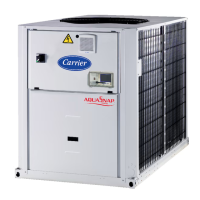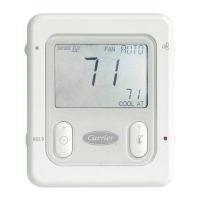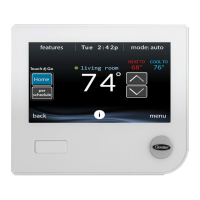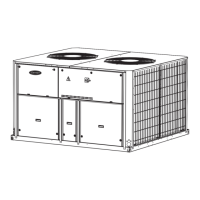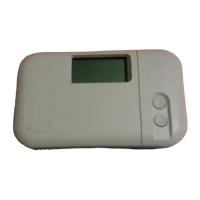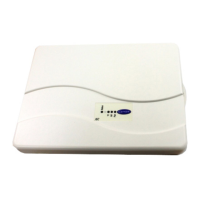6.7.2 - Reset
Reset means the active setpoint is modied so that less machine
capacity is required. In the cooling mode the setpoint is increased,
whereas in the heating mode it is decreased.
The reset can be based on the following possibilities:
■ OAT that gives the measure of the load trends for the building.
■ Return water temperature (ΔT provides the average building
load).
■ Space temperature (EMM option).
■ Dedicated 4-20 mA input (EMM option).
The reset source and the reset parameters can be congured in
the Main menu (RESETCFG – Reset Conguration). In response
to a drop in the reset source (e.g. OAT), the cooling setpoint is
normally reset upwards to optimise unit performance.
The amount of reset is determined by linear interpolation based
on the following parameters:
■ A reference at which reset is zero (no reset value).
■ A reference at which reset is maximum (full reset value).
■ The maximum reset value.
Reset example in Cooling mode:
%Building load
Reset value
20 Reset based on OAT 25
0 Reset based on delta T 3
4 Reset based on analog input 20
no_reset Selection full_reset
Legend
A: Maximum reset value
B: Reference for zero reset
C: Reference for maximum reset
D: Building load
6.8 - Capacity limitation
SmartView allows for the constant control of the unit capacity by
setting its maximum allowable capacity.
Capacity limitation is expressed in percentage, where a limit value
of 100% means that the unit may run with its full capacity (no
limitation is implemented).
The unit capacity can be limited:
■ By means of user-controlled volt-free contacts. Units without
the energy management module have one contact. Units with
the energy management module permit three capacity limitation
levels (see also section 3.6.3). The unit capacity can never
exceed the limit setpoint activated by these contacts. The limit
setpoints can be modied in the SETPOINT menu.
■ By lag limit set by the master unit (master/slave assembly).
If the unit is not in the Master/Slave assembly, the lag limit value
is equal to 100%.
■ By night mode limitation control. The demand limit value in the
night mode is selectable if the value is below the selected limit.
To set limit setpoints
1. Navigate to the Main menu.
2. Select Setpoint Conguration (SETPOINT).
3. Set Switch Limit Setpoint 1 / 2 / 3 [lim_sp1 / 2 / 3].
Switch Limit Setpoint 1 / 2 / 3 [lim_sp1 / 2 / 3]
0 to 100% 100%
To verify lag limit set by the master unit
1. Navigate to the Main menu.
2. Select General Parameters (GENUNIT).
3. Verify Lag Capacity Limit Value [LAG_LIM].
Lag Capacity Limit Value [LAG_LIM]
0 to 100% 100%
To set the night mode limit
1. Navigate to the Conguration menu.
2. Select General Conguration (GEN_CONF).
3. Set Night Capacity Limit [nh_limit].
Night Capacity Limit [nh_limit]
0 to 100% 100%
Based on the limit source, the active demand limit value (DEM_
LIM) is set to the lowest possible value.
DEM_LIM can be forced by Network.
To verify active demand limit value
1. Navigate to the Main menu.
2. Select General Parameters (GENUNIT).
3. Verify Active Demand Limit Val [DEM_LIM].
Active Demand Limit Val [DEM_LIM]
0 to 100% -
6 - STANDARD CONTROL OPERATIONS AND OPTIONS
41
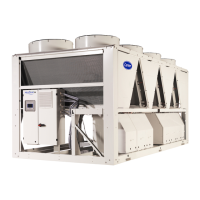
